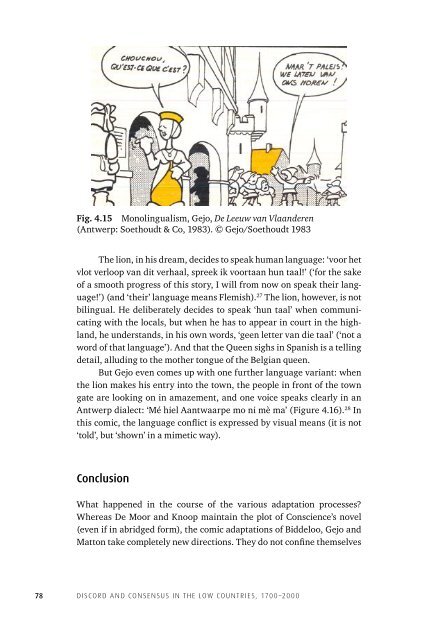Discord Consensus
7aze300jFJo
7aze300jFJo
Create successful ePaper yourself
Turn your PDF publications into a flip-book with our unique Google optimized e-Paper software.
Fig. 4.15 Monolingualism, Gejo, De Leeuw van Vlaanderen<br />
(Antwerp: Soethoudt & Co, 1983). © Gejo/Soethoudt 1983<br />
The lion, in his dream, decides to speak human language: ‘voor het<br />
vlot verloop van dit verhaal, spreek ik voortaan hun taal!’ (‘for the sake<br />
of a smooth progress of this story, I will from now on speak their language!’)<br />
(and ‘their’ language means Flemish). 27 The lion, however, is not<br />
bilingual. He deliberately decides to speak ‘hun taal’ when communicating<br />
with the locals, but when he has to appear in court in the highland,<br />
he understands, in his own words, ‘geen letter van die taal’ (‘not a<br />
word of that language’). And that the Queen sighs in Spanish is a telling<br />
detail, alluding to the mother tongue of the Belgian queen.<br />
But Gejo even comes up with one further language variant: when<br />
the lion makes his entry into the town, the people in front of the town<br />
gate are looking on in amazement, and one voice speaks clearly in an<br />
Antwerp dialect: ‘Mé hiel Aantwaarpe mo ni mè ma’ (Figure 4.16). 28 In<br />
this comic, the language conflict is expressed by visual means (it is not<br />
‘told’, but ‘shown’ in a mimetic way).<br />
Conclusion<br />
What happened in the course of the various adaptation processes?<br />
Whereas De Moor and Knoop maintain the plot of Conscience’s novel<br />
(even if in abridged form), the comic adaptations of Biddeloo, Gejo and<br />
Matton take completely new directions. They do not confine themselves<br />
78<br />
DISCORD AND CONSENSUS IN THE LOW COUNTRIES, 1700–2000


